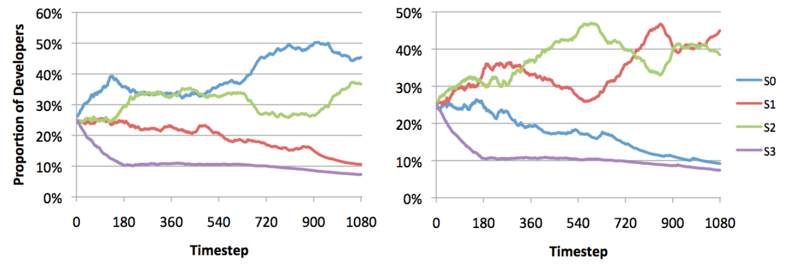| The Artificial Life of the App Store - the Best Strategy to Succeed |
| Written by Alex Armstrong |
| Sunday, 22 April 2012 |
|
How does the Apple App Store actually work? What is the best strategy to employ if you want to get some users and makes some money? There are some pointers on how it all works from an unusual source - artificial life. If you have ever considered creating an app and getting rich, and which programmer hasn't, perhaps you have pondered the best way to approach the problem. Some programmers are innovators and need no input to create something new. Some programmers simply look at what is already successful and copy it. The question is how to pick what sort of app you implement? What is the best strategy if you simply want to make money - to be brilliant or a cloner? The answer could be found from the detailed stats of the App Store, but these are a closely guarded secret. Instead, two researchers at University College, London have invented a clever way of exploring the way the App Store works, and its a technique that could be applied to a wide range of market mechanisms. Soo Ling Lim and Peter Bentley are experts in the subject of artificial life and they came up with the idea of simulating the App Store as an ecosystem. First they proposed five types of developer, and you won't find it hard to recognize them: S0 - the innovator always builds apps with a wide range of novel features. S1- the milker who implements slight largely unnecessary variations on a single app. S2 - the optimizer who simply releases improvements on their most successful app. S3 - the copycat simply copies the best apps in the market. S* - the flexible developer who adopts whichever strategies seems good at the moment. As developers, we tend to dislike the copycat and the milker who are perceived to use crude and almost unethical techniques just to make money. The milker is also disliked by users who tend to notice that they are flooding the market with apps that are hardly different. The AppEco algorithm was invented to simulate the way that these different types of developer affect the market.
The users preferences can be set to model market forces such as a New Apps Chart and a Most Popular Apps Chart. There is, of course, feedback in that the apps selected by the users change the Most Popular Apps listings.The way that the population of user and developer agents changes over time was also set to fit in with the known statistics of the real App Store.
The simulation was used to answer three main questions. The first is the one that might interest the developer the most- which strategy is best? Should you be an innovator or a copier? The answer is depressing in that the CopyCat developer was most successful. The Milker also did quite well, but only by producing a lot of apps none of which sold particularly well. The Innovator did the worst on average but did provide high rewards but only very occasionally. The second question is of more interest to users. What strategy produces the widest diversity of apps? The answer is the Innovator strategy with the CopyCat being the worst - basically because it just copies what is already in the market. The third question is which strategy improves performance with experience? The answer to this one is fairly obvious. Only the Optimizer makes more money as they refine their apps. The other carry on getting the same number of downloads on average. A bigger question that the study attempted to answer was which strategy will win out when developers are allowed to choose the currently best performing strategy. This revealed that while CopyCat is an effective strategy its use drops to around 10% of the developer population very quickly. This seems almost counter intuitive until you realize that CopyCat is a strategy that can only be successful if it is a minority strategy. If everyone was a CopyCat what would they copy? It seems that the market can support about a 10% CopyCat population - any more and the strategy collapses. Which proved the best strategies over time was extremely variable as you can see in two typical runs charted below:
There are other interesting conclusions in the paper How to be a Successful App Developer: Lessons from the Simulation of an App Ecosystem to be presented at the GECCO computing conference in Philadelphia, Pennsylvania, in July. What is clear is that this is an interesting methodology. It broadly agrees with our intuitions about how an app market works and unlike analytical approaches it has lots of scope for customization. For example you could easily add another class of developer to the mix. The software used is available on request. It seems that simulated ecosystems are for more than just biological ecosystems - and it gives idea of viral marketing a new twist.
More InformationHow to be a successful app developer: lessons from the simulation of an app ecosystem Soo Ling Lim and Peter J. Bentley (2012)
Comments
or email your comment to: comments@i-programmer.info
To be informed about new articles on I Programmer, subscribe to the RSS feed, follow us on Google+, Twitter, Linkedin or Facebook or sign up for our weekly newsletter.
|
| Last Updated ( Sunday, 22 April 2012 ) |




